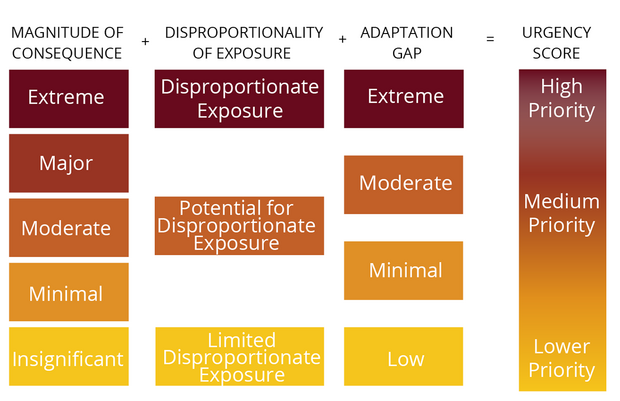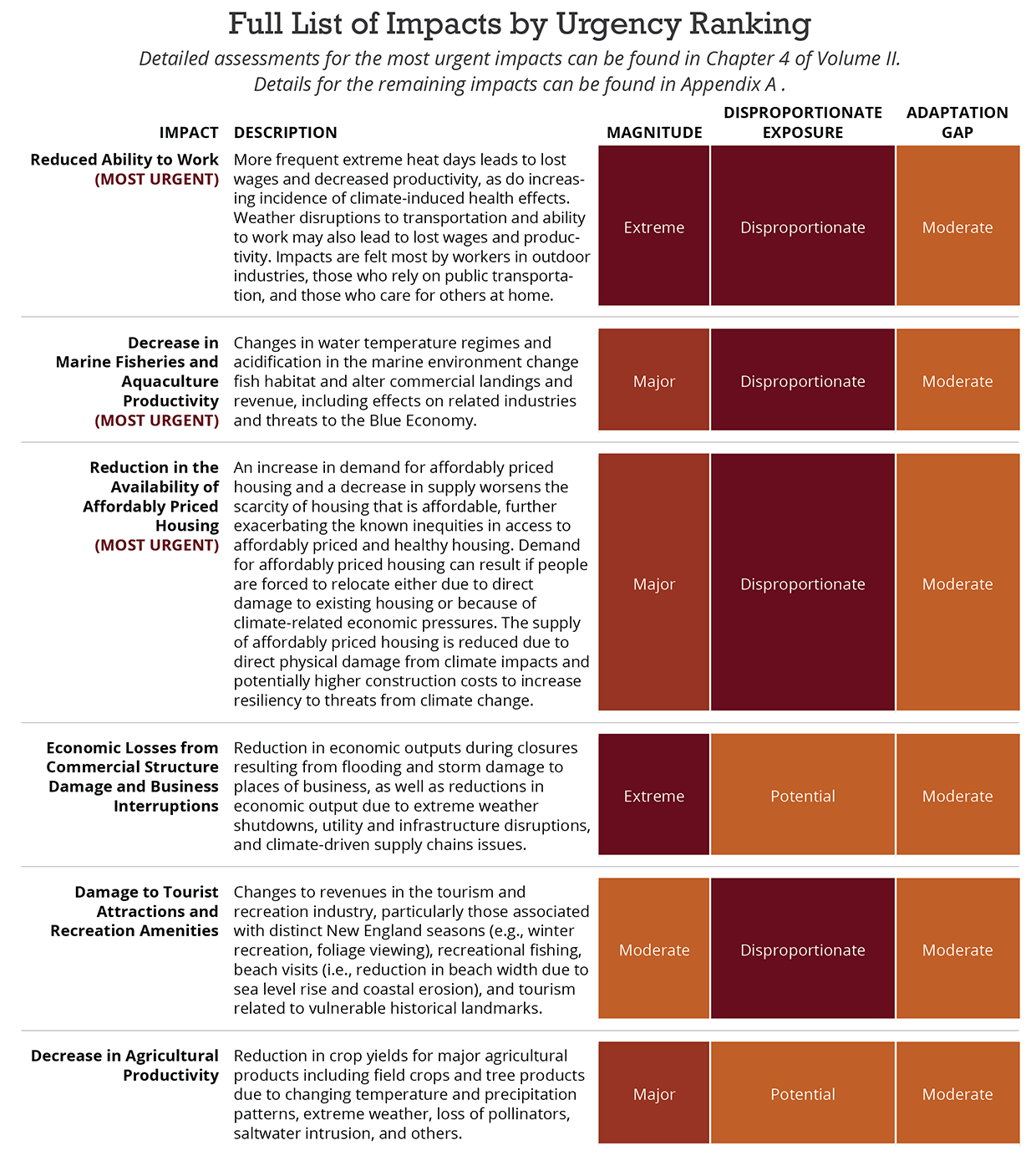Overview
This Climate Assessment considers impacts across five sectors which represent major categories of projected impacts of climate change with common groupings of exposed assets, individuals, or resources, and that generally fall under the responsibility of similar state agencies. The primary objective of the Climate Assessment is to identify urgent climate risk statewide, as well as by each region and sector. Risk rankings were developed through discussions with the project working group and stakeholders, and considered:
-
How big of a climate effect will this have? Quantitative and qualitative indicators of the scale of potential impact, analyzed under the defined future climate scenario.
-
Will populations living in environmental justice areas be disproportionately affected? Demographic analysis of the distribution of impact across populations, particularly the Commonwealth’s identified environmental justice and socially vulnerable groups.
-
Are we currently doing enough to adapt to this impact? Assessment of current and planned adaptation plans and actions, and the potential benefits of additional adaptation action.
Sectors are a helpful organizational structure and allow for the prioritization across impacts with similar types of effects. However, it is important to note that the effects of climate change do not fall neatly within the defined sectors, and there are many interactions between impacts both within and across sectors. To the extent possible, these interactions are noted in the Climate Assessment in order to help draw these connections that may not be seen in the quantitative sectoral analysis.
Full List of Impacts in the Economy Sector
Nine impacts were evaluated within the Economy Sector. Detailed assessments for the most urgent impacts can be found below and in Chapter 4 of Volume II. Details for the remaining impacts can be found in Appendix A.
Most Urgent Impact: Reduced Ability to Work
More frequent extreme heat days leads to lost wages and decreased productivity, as do increasing incidence of climate-induced health effects (e.g., asthma, allergies, vector borne disease, extreme heat). Weather-induced disruptions to transportation and ability to work may also lead to lost wages and worker productivity. Impacts are felt most by workers in outdoor industries, those who rely on public transportation, and those who care for others at home.
Extreme Level of Consequence
Workers in Massachusetts could lose over 10 million hours of work and associated wages per year by 2090 due to high heat conditions plus additional losses due to transportation delays.
Disproportionate Exposure
Calculated disproportionality scores are relatively small; however, people earning lower incomes are less likely to have flexibility for remote work to mitigate commute issues during extreme weather.
Moderate Adaptation Gap
Flood and heat mitigation strategies will help improve workforce resilience indirectly but direct planning, such as increased worker protections, have yet to be adopted on a large scale.
Most Urgent Impact: Decrease in Marine Fisheries and Aquaculture Productivity
Changes in water temperature regimes and acidification in the marine environment change fish habitat and alter commercial landings and revenue, including effects on related industries.
Major Level of Consequence
Changing species distributions may result in a decrease in marine industry revenue of nearly $70 million per year by 2090.
Disproportionate Exposure
Populations with low incomes live in areas with 203 percent higher projected impacts to marine fishery landings compared to the rest of the coast.
Moderate Adaptation Gap
Little action has taken place to date to address the climate-related damages caused to marine fisheries and aquaculture despite the industries being major contributors to many coastal economies.
Most Urgent Impact: Reduction in the Availability of Affordably Priced Housing
An increase in demand for affordably priced housing and a decrease in supply worsens the scarcity of housing that is affordable, further exacerbating the known inequities in access to affordably priced and healthy housing. Demand for affordably priced housing can result if people are forced to relocate either due to direct damage to existing housing or because of climate-related economic pressures. The supply of affordably priced housing is reduced due to direct physical damage from climate impacts and potentially higher construction costs to increase resilience to threats from climate change.
Major Level of Consequence
Direct impacts on specific structures are difficult to identify, but among block groups up to 25th percentile for residential structure value, in 2030 up to 6,500 households could experience 0.5 percent or more of expected annual damage to structures from flooding, increasing to 36,000 by 2090.
Disproportionate Exposure
Impacts are focused on low-income populations living primarily in housing with the lowest value in the state.
Moderate Adaptation Gap
Actions and plans are underway outside of climate planning processes to address housing affordability but more work is needed, particularly to address the specific risks of climate change on subsidized affordable housing.
Quick links
- ResilientMass Homepage
- ResilientMass Site Map
- Massachusetts Climate Change Assessment
- Massachusetts Climate Change Assessment – Human Sector
- Massachusetts Climate Change Assessment – Infrastructure Sector
- Massachusetts Climate Change Assessment – Natural Environment Sector
- Massachusetts Climate Change Assessment – Governance Sector
- Massachusetts Climate Change Assessment – Full Statewide Report Volume II
- Massachusetts Climate Change Assessment – Full Statewide Report Volume II, Appendix A
- 2023 ResilientMass Plan
- 2023 ResilientMass Action Tracker





